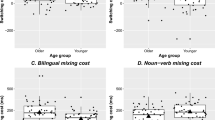Abstract
The asymmetry model of bilingual memory proposed by Kroll and Stewart assumes that translation from a first language (L1) into a second language (L2), or forward translation, is mediated by an underlying conceptual memory, whereas L2-to-L1, or backward, translation is lexical and direct. Lexical links from L2 to L1 are hypothesized to be stronger than those from L1 to L2, but conceptual links are stronger for L1 than L2. These assumptions were evaluated in this study, which used stimulus items with similar recognition thresholds. Proficient Chinese-English bilinguals were tested on picture naming, word naming, word translation and category matching. The translation asymmetry effect predicted by the model (i.e., backward being faster than forward translation) was demonstrated; matching an L1 item to a category name was also faster than matching an L2 item. This pattern of results, nevertheless, did not completely hold after an adjustment procedure which sought to control for variations in response production and concept retrieval times due to stimulus types. The present findings are consistent with previous ones which show increased L2 conceptual processing for the proficient bilingual. They also suggest that an extended version of the asymmetry model should take into account possible biasing effects associated with some conventionally used bilingual tasks.
Similar content being viewed by others
References
Altarriba, J. (1990). Constraints on interlingual facilitation effects in priming in Spanish-English bilinguals. Unpublished dissertation. Vanderbilt University.
Chen, H.-C. (1990). Lexical processing in a non-native language: Effects of language proficiency and learning strategy. Memory & Cognition, 18, 279–288
Chen, H.-C. (1992). Reading comprehension in Chinese: Implications from character reading times. In H.-C. Chen and O.J.L. Tzeng (Eds.) Language processing in Chinese (pp. 175–205). Amsterdam: Elsevier.
Chen, H.-C. (1996). Chinese reading and comprehension: Cognitive psychology perspective. In M. H. Bond (Ed.), The handbook of Chinese psychology (pp. 43–62). HK: Oxford University Press.
Chen, H.-C. & Ho, C. (1986). Development of Stroop interference in Chinese-English bilinguals. Journal of Experimental Psychology: Learning, Memory & Cognition, 12, 397–401.
Chen, H.-C. & Leung, Y. S. (1989). Patterns of lexical processing in a nonnative language. Journal of Experimental Psychology: Learning, Memory & Cognition, 15, 316–325.
Chen, H.-C. & Ng, M. L. (1989). Semantic facilitation and translation priming effects in Chinese-English bilinguals. Memory & Cognition, 17, 454–462.
Dufour, R. & Kroll, J. F. (1995). Matching words to concepts in two languages: A test of concept mediation model of bilingual representation. Memory & Cognition, 23, 166–180.
Durgunoglu, A. Y. & Roediger, H. L., III (1987). Test differences in accessing bilingual memory. Journal of Memory & Language, 26, 377–391.
de Groot, A. M. B. (1992a). Bilingual lexical representation: A closer look at conceptual representations. In R. Frost & L. Katz (Eds.), Orthography, phonology, morphology, & meaning (pp. 389–412). Amsterdam: Elsevier.
de Groot, A. M. B. (1992b). Determinants of word translations. Journal of Experimental Psychology: Learning, Memory & Cognition, 18, 1001–1008.
de Groot, A. M. B., Dannenburg, L., & van Hell, J. G. (1994). Forward and backward word translation. Journal of Memory & Language, 33, 600–629.
Heredia, R., McLaughlin, B. (1992). Bilingual memory revisited. In R. J. Harris (Ed.), Cognitive processing in bilinguals (Vol. 83, pp. 91–103. Amsterdam: Elsevier.
Huang, H. S. & Hanley, J. R. (in press). A longitudinal study of phonological awareness, visual skills and Chinese reading acquisition amongst first graders in Taiwan. International Journal of Behavioral Development.
Kroll, J. F. & Curley, J. (1988). Lexical memory in novice bilinguals: The role of concepts in retrieving second language words. In M. Gruneberg, P. Morris, & R Sykes (Eds.) Practical aspects of memory (Vol. 2, pp. 389–395). London: John Wiley & Sons.
Kroll, J. F. & Stewart, E. (1990, November). Concept mediation in bilingual translation. Paper presented at the 31st annual meeting of the Psychonomic Society, New Orleans.
Kroll, J. F. & Stewart, E. (1994). Category interference in translation and picture naming: Evidence for asymmetric connections between bilingual memory representations. Journal of Memory & Language, 33, 149–174.
La Heij, W., Hooglander, A, Kerling, R., & van der Velden, E. (1996). Nonverbal context effects in forward and backward word translation: Evidence for concept mediation. Journal of Memory and Language, 35, 648–665
Potter, M. C., So, K. F., von Eckardt, B., & Feldman, L. B. (1984). Lexical and conceptual representation in beginning and proficient bilinguals. Journal of Verbal Learning & Verbal Behavior, 23, 23–38.
Sholl, A. (1993). Memory performance following bilingual translation: Lexical and conceptual determinants of cross-language transfer. Unpublished master's thesis, University of Massachusetts.
Sholl, A., Sankaranarayanan, A., & Kroll, J. F. (1995). Transfer between picture naming and translation: A test of asymmetries in bilingual memory. Psychological Science, 6, 45–49.
Snodgrass, J. G. (Ed.). (1984). Concepts and their surface representations [Special issue]. Journal of Verbal Learning and Verbal Behavior, 23.
Snodgrass, J. G. (1993). Translating versus picture naming: Similarities and differences In R. Schreuder & B. Weltens (Eds.) The bilingual lexicons (pp. 83–114). Amsterdam: John Benjamins.
Snodgrass, J. G. & Vanderward, M. (1980). A standardized set of 260 pictures: Norms for name agreement, image agreement, familiarity, and visual complexity. Journal of Experimental Psychology: Human Learning and Memory, 6, 174–215.
Author information
Authors and Affiliations
Corresponding author
Rights and permissions
About this article
Cite this article
Chen, HC., Cheung, H. & Lau, S. Examining and reexamining the structure of Chinese-English bilingual memory. Psychol. Res 60, 270–283 (1997). https://doi.org/10.1007/BF00419413
Received:
Accepted:
Issue Date:
DOI: https://doi.org/10.1007/BF00419413




